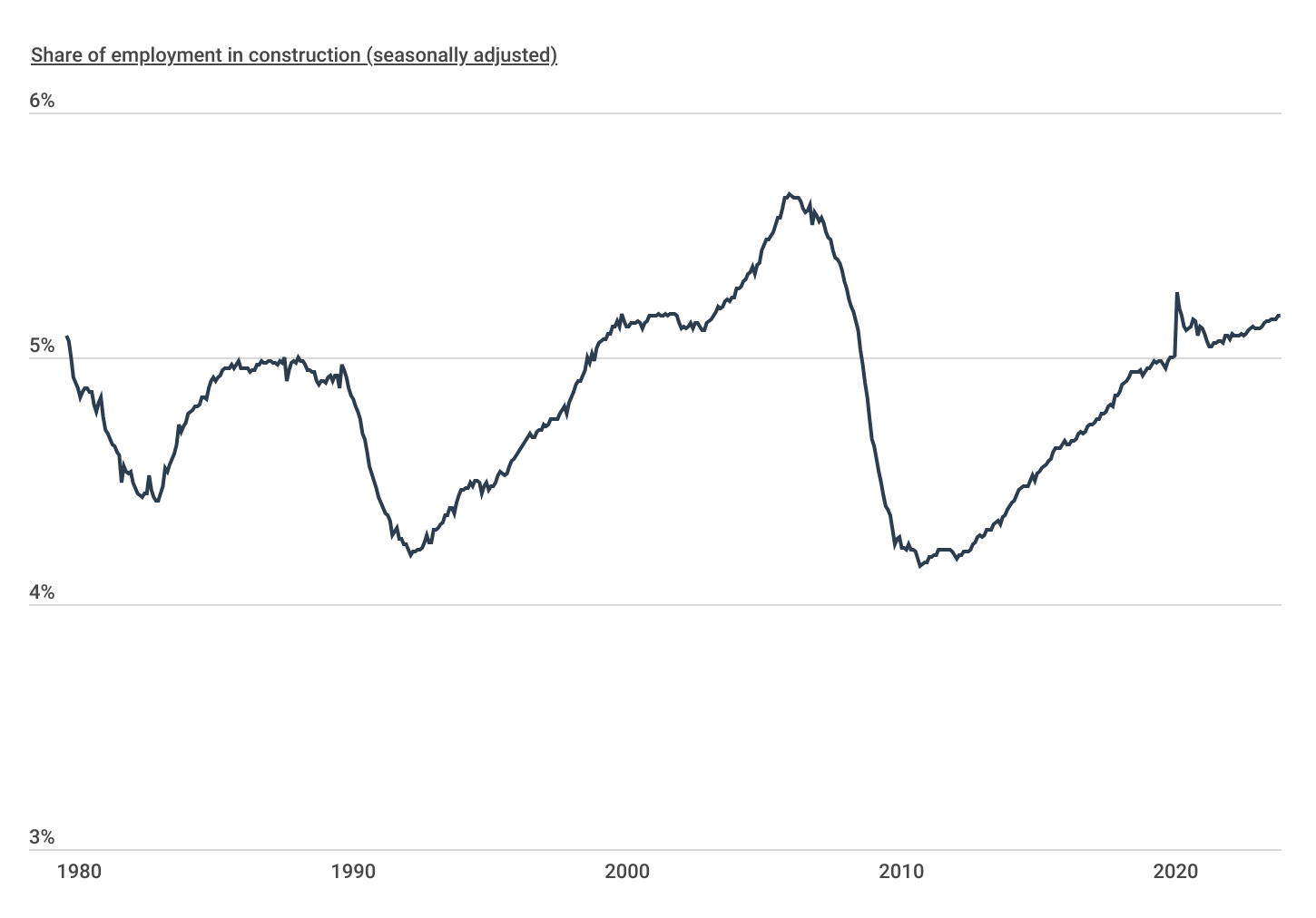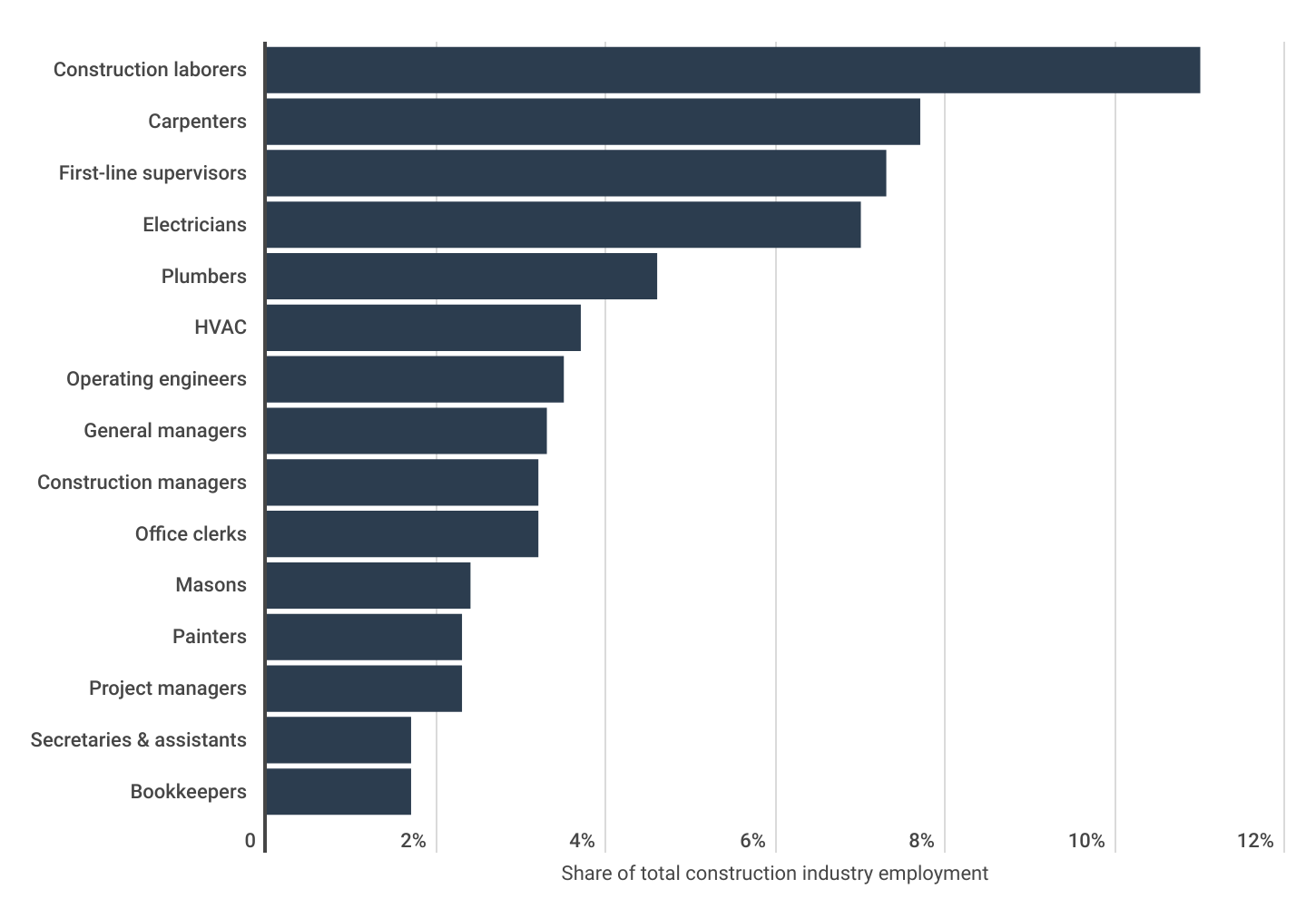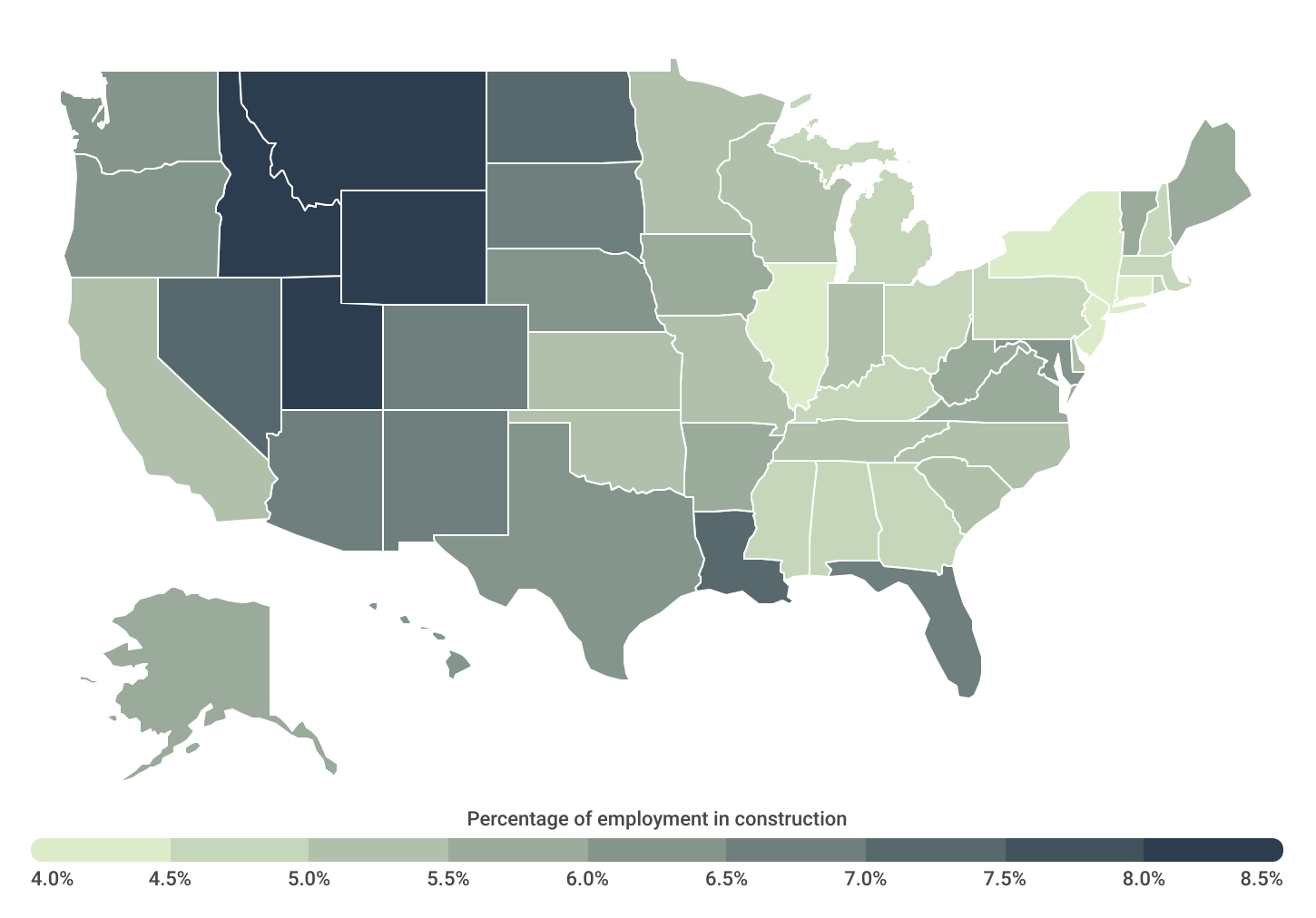Cities With the Most Construction Workers
Note: This is the most recent release of our Cities With the Most Construction Workers study. To see data from prior years, please visit the Full Results section below.
The Great Recession left a lasting impact on the American economy, especially in the housing market. From 2007 to 2010, the subprime mortgage crisis led to the widespread devaluation of residential properties and discouraged builders from investing in new housing construction. As a consequence, the number of new housing construction starts plummeted, and the repercussions of the recession continue to be felt in the construction industry to this day.
Despite these adversities, construction workers remain a vital component of the American workforce, driving economic growth through their work in essential sectors. Their efforts serve as a foundation for initiatives aimed at expanding the supply of residential housing and bolstering a waning American manufacturing industry. By building the houses, buildings, and infrastructure necessary to achieve these goals, construction workers make significant contributions to the country’s economic development.
Trends in Construction Employment
Construction employment still remains below pre-Great Recession levels

More than a decade after the Great Recession, employment within the construction sector continues to lag behind pre-recession levels. Following the housing market crash in 2008, construction jobs experienced a significant decline, with the full impact not being realized until January 2011 when the share of total employment hit a 30-year low of just 4.15%.
Since then, however, employment in construction has grown. Apart from the brief spike during the COVID-19 pandemic—when many construction professionals were considered essential workers and most other workers faced mass unemployment—the share of total employment in the construction industry rose steadily. As of February 2024, the share of employment in construction stands at 5.17%.
FOR CONSTRUCTION BUSINESSES
Do you operate a construction business? Then you know it’s important to have the right tools for the job. Check out our updated guide on the best construction project management software to get started.
Construction Industry Occupations With the Most Employees
The construction industry employs a diverse set of workers

This trend not only affects laborers and trades workers typically associated with the construction industry, but also impacts a diverse array of professionals who support, manage, and employ these workers. While laborers and specialty contractors account for most construction industry jobs, other common roles include general managers (3.3% of total construction industry employment), construction managers (3.2%), office clerks (3.2%), project managers (2.3%), secretaries and assistants (1.7%), and bookkeepers (1.7%).
FOR CONSTRUCTION PROFESSIONALS
Planning a new construction project? The best takeoff software and estimating software will improve the accuracy of your bids and save you time and money in the long run.
Regional Disparities in Construction Employment
The Mountain West relies most heavily on the construction industry for jobs

Construction employment varies significantly across the country, with states in the Mountain West region—such as Wyoming (8.4%), Utah (8.2%), Idaho (8.1%), Montana (8.0%), and Nevada (7.4%)—relying most heavily on construction industry jobs. This trend also holds true at the metropolitan level, with four large Mountain West metros ranking within the top 10 for the largest concentration of construction industry workers.
Some point to the combination of the region’s business-friendly tax and regulatory environment with the renewed effort to reshore critical industries as a key driver of manufacturing-related construction in the area. However, it’s important to recognize that rapid population growth in the region has also played a significant role. The influx of residents has created substantial demand for new housing and infrastructure projects, driving elevated levels of construction activity.
Below is a breakdown of changes in construction industry employment across over 380 metros and all 50 states conducted by Construction Coverage using data from the U.S. Bureau of Labor Statistics. For more detailed information, refer to the methodology section.
Large Metros With the Most Construction Workers
| Top Metros | Employment* |
|---|---|
| 1. Phoenix-Mesa-Chandler, AZ | 7.4% |
| 2. Las Vegas-Henderson-Paradise, NV | 7.4% |
| 3. Houston-The Woodlands-Sugar Land, TX | 7.2% |
| 4. Riverside-San Bernardino-Ontario, CA | 7.2% |
| 5. Sacramento-Roseville-Folsom, CA | 7.2% |
| 6. Raleigh-Cary, NC | 7.1% |
| 7. Salt Lake City, UT | 7.0% |
| 8. Denver-Aurora-Lakewood, CO | 6.8% |
| 9. Portland-Vancouver-Hillsboro, OR-WA | 6.8% |
| 10. Jacksonville, FL | 6.7% |
| 11. Orlando-Kissimmee-Sanford, FL | 6.5% |
| 12. Tampa-St. Petersburg-Clearwater, FL | 6.4% |
| 13. Austin-Round Rock-Georgetown, TX | 6.4% |
| 14. Richmond, VA | 6.4% |
| 15. Seattle-Tacoma-Bellevue, WA | 6.1% |
| Bottom Metros | Employment* |
|---|---|
| 1. Hartford-East Hartford-Middletown, CT | 3.7% |
| 2. Memphis, TN-MS-AR | 4.0% |
| 3. Buffalo-Cheektowaga, NY | 4.2% |
| 4. Cleveland-Elyria, OH | 4.2% |
| 5. Philadelphia-Camden-Wilmington, PA-NJ-DE-MD | 4.2% |
| 6. Los Angeles-Long Beach-Anaheim, CA | 4.2% |
| 7. New York-Newark-Jersey City, NY-NJ-PA | 4.2% |
| 8. Chicago-Naperville-Elgin, IL-IN-WI | 4.3% |
| 9. Cincinnati, OH-KY-IN | 4.4% |
| 10. Detroit-Warren-Dearborn, MI | 4.4% |
| 11. Milwaukee-Waukesha, WI | 4.7% |
| 12. Columbus, OH | 4.7% |
| 13. Atlanta-Sandy Springs-Alpharetta, GA | 4.8% |
| 14. Louisville/Jefferson County, KY-IN | 4.9% |
| 15. San Jose-Sunnyvale-Santa Clara, CA | 4.9% |
TRENDING
Unfortunately, many contractors are underinsured. Before breaking ground on your next job, make sure you have adequate workers comp insurance to protect your employees and commercial truck insurance to protect your vehicles.
Midsize Metros With the Most Construction Workers
| Top Metros | Employment* |
|---|---|
| 1. Cape Coral-Fort Myers, FL | 13.9% |
| 2. Naples-Marco Island, FL | 12.6% |
| 3. Baton Rouge, LA | 12.0% |
| 4. Greeley, CO | 11.7% |
| 5. Beaumont-Port Arthur, TX | 11.6% |
| 6. Corpus Christi, TX | 10.9% |
| 7. Provo-Orem, UT | 10.6% |
| 8. North Port-Sarasota-Bradenton, FL | 9.6% |
| 9. Boise City, ID | 8.9% |
| 10. Reno, NV | 8.8% |
| 11. Port St. Lucie, FL | 8.6% |
| 12. Vallejo, CA | 8.5% |
| 13. Ogden-Clearfield, UT | 8.3% |
| 14. Santa Rosa-Petaluma, CA | 7.9% |
| 15. Salem, OR | 7.8% |
| Bottom Metros | Employment* |
|---|---|
| 1. Ann Arbor, MI | 2.3% |
| 2. Brownsville-Harlingen, TX | 2.6% |
| 3. Trenton-Princeton, NJ | 2.8% |
| 4. McAllen-Edinburg-Mission, TX | 3.0% |
| 5. Durham-Chapel Hill, NC | 3.1% |
| 6. Hickory-Lenoir-Morganton, NC | 3.4% |
| 7. Salinas, CA | 3.5% |
| 8. Harrisburg-Carlisle, PA | 3.6% |
| 9. Allentown-Bethlehem-Easton, PA-NJ | 3.6% |
| 10. Huntsville, AL | 3.7% |
| 11. Bridgeport-Stamford-Norwalk, CT | 3.9% |
| 12. Dayton-Kettering, OH | 4.0% |
| 13. Montgomery, AL | 4.1% |
| 14. Scranton–Wilkes-Barre, PA | 4.1% |
| 15. Columbia, SC | 4.2% |
Small Metros With the Most Construction Workers
| Top Metros | Employment* |
|---|---|
| 1. Dover, DE | 26.4% |
| 2. St. George, UT | 11.9% |
| 3. Lake Charles, LA | 10.8% |
| 4. Punta Gorda, FL | 10.6% |
| 5. The Villages, FL | 10.2% |
| 6. Coeur d’Alene, ID | 9.7% |
| 7. Homosassa Springs, FL | 9.3% |
| 8. Fairbanks, AK | 9.1% |
| 9. Bend, OR | 9.0% |
| 10. Sebastian-Vero Beach, FL | 8.7% |
| 11. St. Cloud, MN | 8.4% |
| 12. Prescott Valley-Prescott, AZ | 8.4% |
| 13. Rapid City, SD | 8.3% |
| 14. Great Falls, MT | 8.3% |
| 15. Longview, TX | 8.2% |
| Bottom Metros | Employment* |
|---|---|
| 1. Weirton-Steubenville, WV-OH | 1.2% |
| 2. Hinesville, GA | 1.9% |
| 3. Laredo, TX | 1.9% |
| 4. Rome, GA | 2.0% |
| 5. Ithaca, NY | 2.0% |
| 6. Dalton, GA | 2.1% |
| 7. Hanford-Corcoran, CA | 2.3% |
| 8. Anniston-Oxford, AL | 2.5% |
| 9. El Centro, CA | 2.6% |
| 10. Johnson City, TN | 2.6% |
| 11. Danville, IL | 2.8% |
| 12. Springfield, OH | 2.8% |
| 13. Utica-Rome, NY | 2.8% |
| 14. Springfield, IL | 3.0% |
| 15. Boulder, CO | 3.0% |
States With the Most Construction Workers
| Top States | Employment* |
|---|---|
| 1. Wyoming | 8.4% |
| 2. Utah | 8.2% |
| 3. Idaho | 8.1% |
| 4. Montana | 8.0% |
| 5. Nevada | 7.4% |
| 6. North Dakota | 7.4% |
| 7. Louisiana | 7.1% |
| 8. Arizona | 6.9% |
| 9. Colorado | 6.7% |
| 10. New Mexico | 6.7% |
| 11. South Dakota | 6.7% |
| 12. Florida | 6.6% |
| 13. Texas | 6.3% |
| 14. Oregon | 6.3% |
| 15. Nebraska | 6.3% |
| Bottom States | Employment* |
|---|---|
| 1. Connecticut | 4.1% |
| 2. New Jersey | 4.1% |
| 3. Illinois | 4.1% |
| 4. New York | 4.3% |
| 5. Mississippi | 4.5% |
| 6. Michigan | 4.6% |
| 7. Georgia | 4.6% |
| 8. Ohio | 4.6% |
| 9. Rhode Island | 4.7% |
| 10. Kentucky | 4.7% |
| 11. Pennsylvania | 4.7% |
| 12. New Hampshire | 4.8% |
| 13. Alabama | 4.9% |
| 14. Massachusetts | 4.9% |
| 15. Kansas | 5.0% |
*Percentage of employment in construction
Methodology
To determine the locations with the most construction workers, researchers at Construction Coverage analyzed the latest data from the U.S. Bureau of Labor Statistics’ Quarterly Census of Employment and Wages. The researchers ranked locations by the percentage of total employment in the construction industry in Q3 2023, the latest data available. In the event of a tie, the location with the greater total number of construction industry employees was ranked higher. To improve relevance, only metropolitan areas with complete data were included, and they were grouped into cohorts based on population size: small (less than 350,000), midsize (350,000–1,000,000), and large (more than 1,000,000).
References
- U.S. Census Bureau and U.S. Department of Housing and Urban Development. (2024, March 19). New Privately-Owned Housing Units Started: Total Units. Retrieved on March 29, 2024 from https://fred.stlouisfed.org/series/HOUST.
- The White House. (2024, February 29). FACT SHEET: Biden-Harris Administration Announces New Actions to Boost Housing Supply and Lower Housing Costs. Retrieved on March 29, 2024 from https://www.whitehouse.gov/briefing-room/statements-releases/2024/02/29/fact-sheet-biden-harris-administration-announces-new-actions-to-boost-housing-supply-and-lower-housing-costs/.
- The White House. (2024, February 9). FACT SHEET: Biden-Harris Administration Announces Over $5 Billion from the CHIPS and Science Act for Research, Development, and Workforce. Retrieved on March 29, 2024 from https://www.whitehouse.gov/briefing-room/statements-releases/2024/02/09/fact-sheet-biden-harris-administration-announces-over-5-billion-from-the-chips-and-science-act-for-research-development-and-workforce/.
- National Conference of State Legislatures (NCSL). (2021, January 11). COVID-19: Essential Workers in the States. Retrieved on March 29, 2024 from https://www.ncsl.org/labor-and-employment/covid-19-essential-workers-in-the-states#trades.
- U.S. Bureau of Labor Statistics. (2024, March 8). Unemployment Rate. Retrieved on March 29, 2024 from https://fred.stlouisfed.org/series/UNRATE.
- Fikri, K. (2023, February 7). The Mountain West Is Winning Manufacturing’s New Build-Out. Economic Innovation Group. Retrieved on March 29, 2024 from https://eig.org/mountain-west-leads-manufacturing-investment/.
- The White House. (2022, February 24). The Biden-Harris Plan to Revitalize American Manufacturing and Secure Critical Supply Chains in 2022. Retrieved on March 29, 2024 from https://www.whitehouse.gov/briefing-room/statements-releases/2022/02/24/the-biden-harris-plan-to-revitalize-american-manufacturing-and-secure-critical-supply-chains-in-2022.
- Rogers, L., et al. (2023, March 30). Domestic Outmigration From Some Urban Counties Slowed, Smaller Gains in Rural Counties. U.S. Census Bureau. Retrieved on March 29, 2024 from https://www.census.gov/library/stories/2023/03/domestic-migration-trends-shifted.html.
- U.S. Bureau of Labor Statistics. (n.d.). Quarterly Census of Employment and Wages. Retrieved on March 29, 2024 from https://www.bls.gov/cew/.
Full Results
Each company featured in our guides has been independently selected and reviewed by our research team. If you select one of these companies and click on a link, we may earn a commission.
By clicking on these links, you may be taken to one of our insurance partners. The specific company listed here may or may not be included in our partner’s network at this time.
